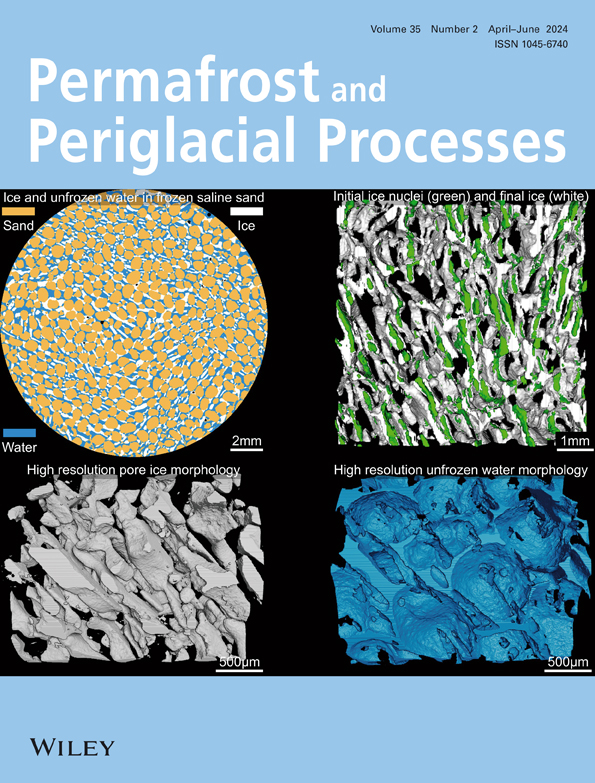Holocene January paleotemperature of northwestern Siberia reconstructed based on stable isotope ratio of ice wedges
IF 3.3
3区 地球科学
Q2 GEOGRAPHY, PHYSICAL
引用次数: 1
Abstract
Ice wedges are considered as a paleoarchive of winter air temperatures as their stable isotope composition has been widely used to reconstruct winter climatic conditions in the Arctic regions. Ice wedge stable isotope records, obtained in recent decades for many Arctic permafrost areas of Russia and North America, demonstrate a clear shift from lower to higher values between the Late Pleistocene and Holocene (by 5–10‰ for δ18O values in some regions of the Russian Arctic), which is widely accepted as evidence of winter air temperature increase. However, the evolution of winter air temperatures during the Holocene is less clear and, according to proxy reconstructions, winter climate trends are not synchronous and may significantly vary throughout the Arctic. In this study, we investigate the stable isotope composition of Holocene syngenetic ice wedges and modern ice veinlets of northwestern Siberia. Radiocarbon dating of enclosing sediments and a few dates of organic material from ice wedges demonstrate that ice wedges grew constantly within the study area during the Holocene though early–mid‐Holocene in northwestern Siberia is often considered as a thermal optimum. In fact, many proxy records indicate an increase of summer air temperatures followed by thermokarst activity, peatland formation, and northward advance of the treeline. According to our data, winter climate conditions in terms of mean air temperature of the coldest winter month (January) did not change significantly during the key Holocene stages, and during the Greenlandian and most of the Northgrippian stages (between 11.4 and 6 cal ka BP) mean January air temperature (TmJ) varied between −21 and −30°C, and from the end of the Northgrippian, during the Meghalayan stages of Holocene (5.2–0.9 cal ka BP), TmJ varied between −24 to −28°C. Mean January air temperature during the Holocene was generally 1–2°C lower than the modern one, meanwhile the submeridional direction of TmJ isotherms and eastward decrease of TmJ values in Holocene are similar to the modern pattern.基于冰楔稳定同位素比值重建西伯利亚西北部全新世1月古地温
冰楔被认为是冬季气温的古档案,其稳定的同位素组成已被广泛用于重建北极地区的冬季气候条件。近几十年来在俄罗斯和北美许多北极多年冻土区获得的冰楔稳定同位素记录表明,在晚更新世和全新世之间,δ18O值明显由低向高转变(俄罗斯北极一些地区δ18O值变化了5-10‰),这被广泛认为是冬季气温升高的证据。然而,全新世冬季气温的演变不太清楚,根据代理重建,冬季气候趋势不是同步的,可能在整个北极地区发生显著变化。本文研究了西伯利亚西北部全新世同生冰楔和现代冰脉的稳定同位素组成。外围沉积物的放射性碳定年和一些冰楔有机物的定年表明,在全新世期间,研究区内的冰楔不断生长,尽管西伯利亚西北部早-中全新世通常被认为是热最佳时期。事实上,许多替代记录表明夏季气温升高,随后是热岩溶活动、泥炭地形成和树线向北推进。研究结果表明,全新世关键时期冬季最冷月份(1月)平均气温变化不显著,格陵兰期和北格里平期(11.4 ~ 6 cal ka BP) 1月平均气温(TmJ)在- 21 ~ - 30°C之间变化,北格里平期结束后,全新世梅加拉亚期(5.2 ~ 0.9 cal ka BP) 1月平均气温(TmJ)在- 24 ~ - 28°C之间变化。全新世1月平均气温普遍比现代低1 ~ 2℃,同时,全新世TmJ等温线的下沉方向和TmJ值的东降趋势与现代相似。
本文章由计算机程序翻译,如有差异,请以英文原文为准。
求助全文
约1分钟内获得全文
求助全文
来源期刊
CiteScore
9.70
自引率
8.00%
发文量
43
审稿时长
>12 weeks
期刊介绍:
Permafrost and Periglacial Processes is an international journal dedicated to the rapid publication of scientific and technical papers concerned with earth surface cryogenic processes, landforms and sediments present in a variety of (Sub) Arctic, Antarctic and High Mountain environments. It provides an efficient vehicle of communication amongst those with an interest in the cold, non-glacial geosciences. The focus is on (1) original research based on geomorphological, hydrological, sedimentological, geotechnical and engineering aspects of these areas and (2) original research carried out upon relict features where the objective has been to reconstruct the nature of the processes and/or palaeoenvironments which gave rise to these features, as opposed to purely stratigraphical considerations. The journal also publishes short communications, reviews, discussions and book reviews. The high scientific standard, interdisciplinary character and worldwide representation of PPP are maintained by regional editorial support and a rigorous refereeing system.

 求助内容:
求助内容: 应助结果提醒方式:
应助结果提醒方式:


